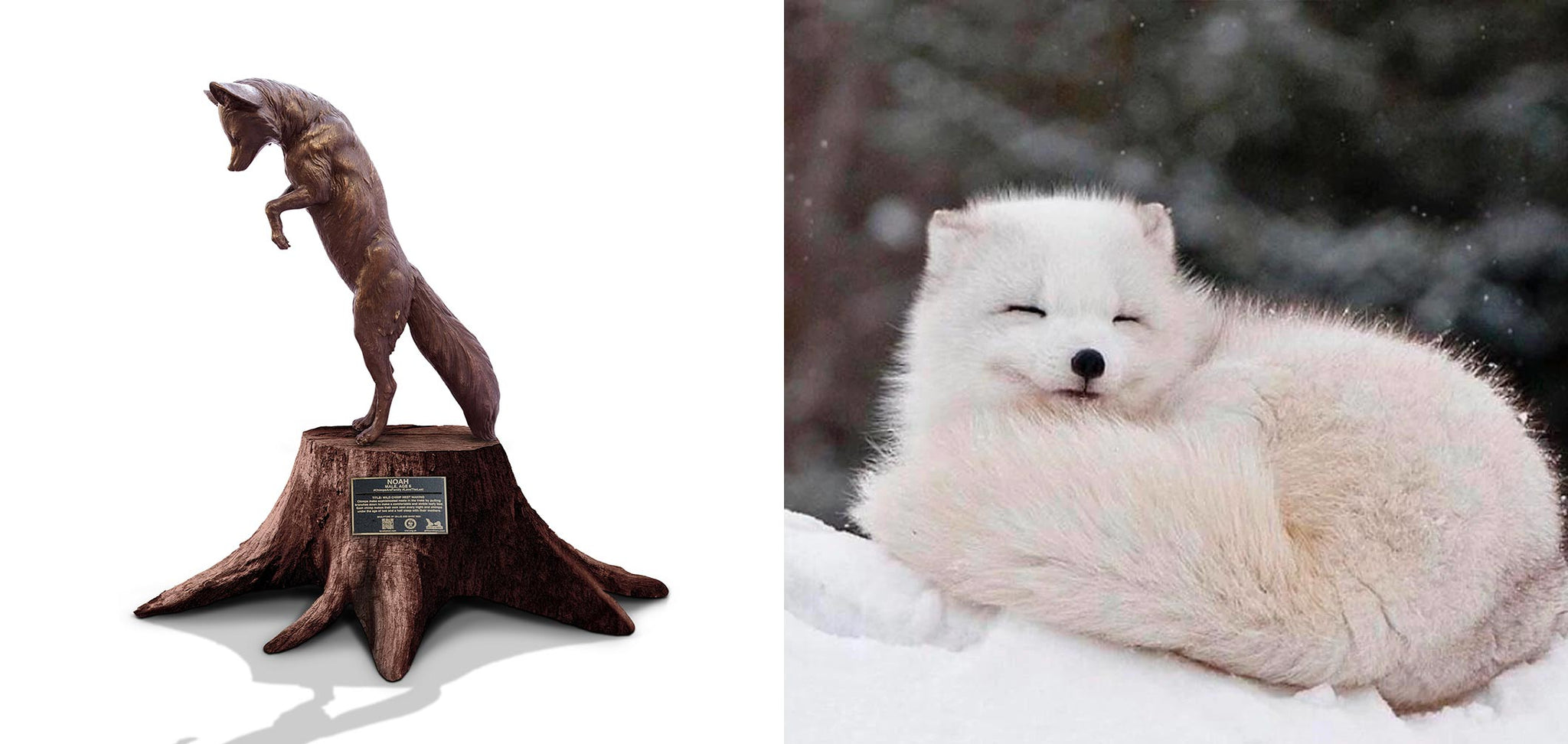Tiny Baby Wonder Arctic Fox

NAME
TITLE
Tiny Baby Wonder Arctic Fox
GENDER
Male
AGE
16 Weeks
FOUND
Northern Hemisphere Arctic Regions
CONSERVATION STATUS
Least Concern
It might be a bit cold for most but this 16-week boy is prepared. He has been tucked away in his huge den with his many siblings safe and sound. They have been drinking all the milk they can and having a great time playing with each other, but he is very interested in the big wide world. His thick white coat should protect him from the elements but he must always have his wits about him, keeping his eyes peeled at all times for the dreaded red fox.
The beautiful Arctic fox may look delicate but it is incredibly hardy. It lives in one of the most inhospitable climates in the world, the Arctic, which spends its winter below freezing and its short summer just above. The fox has developed a thick white coat to perfectly suit its surroundings. Not only is it wonderfully warm with a fluffy tail to wrap around themselves as an added blanket, but it blends in perfectly with the snowy surroundings giving them the camouflage to them an excellent hunter. In the summer it sheds its white coat for a brown/grey one that is ideal for blending in with the ice-free summer. Arctic Foxes are the only canid that has fur on the pads of their feet.
Even though they are exceptional hunters, sometimes the long winter months can be short on food, particularly their favourite cuisine of lemmings. To solve this problem, the crafty hunters follow larger predators like polar bears and wolves to scavenge whatever they manage to find. To help them with their hunting endeavours, the Arctic Fox has developed a spectacular sense of hearing and smell. They can easily hear lemmings burrowing under 4-5 inches of snow and can smell a leftover carcass 10-40km away. Once they have found their prey under the snow they leap into the air, giving them a fantastic vantage to pierce through the snow, catching their prey unaware.
Arctic foxes live in very large dens, which are a system of tunnels, covering up to 1000m2 with many entrances. If their main food source, the lemming, is abundant, the foxes can have litters as big as 25 kits, the largest of any dog- but usually they give birth to between 6-19. Arctic foxes are monogamous so both parents look after their young. The mother will feed the kits with her milk while the father will head out to hunt. The kits are completely dependent on their parents from summer to autumn, leaving the den for the first time when they are 14-15 weeks old and becoming sexually mature once they are a year old.
While the species as a whole is thriving, some populations are critically endangered; in Scandinavia and Medny Island in Russia. With the near extinction of wolves, the red fox became the apex predator, killing many of their arctic cousins and their kits. They are also very susceptible to the varying populations of their prey- when lemming numbers drop, so too does the foxes. Another major problem for the foxes is climate change. The Arctic is seeing rising temperatures at twice the rate of the rest of the world, making huge changes to the habitat of the fox at a speed too fast for them to adapt to.
HOW TO HELP
Based off real animals that Gillie and Marc met while travelling, the public will be able to meet individual animals.
Through public art, more people will come into contact with these sculptures, will stop and consider them, will take a photograph, and will discuss this with their friends and family. With this increased exposure, the message of love, family, and conservation will be spread much further than any piece of art in a gallery ever could. It will bring people into close contact and will help them to fall in love, and with love comes a greater urge to want to create a change and save all endangered animals.
The sculpture will be aligned with the hashtag #LoveTheLast to raise unparalleled awareness about the sculpture’s cause across the globe.
ABOUT GILLIE AND MARC
Gillie and Marc’s highly coveted public artworks can be found worldwide including in New York, London, Singapore, Shanghai, and Sydney. They are Archibald Prize finalists, won the Chianciano Biennale in Italy, took out the Allens People’s Choice Award in 2016 and 2018 and Kids’ Choice Award in the 2016 Sculpture by the Sea and received the Bayside Arts Festival People's Choice Award in 2019 in Sydney.
The husband-and-wife duo are on a mission to make art for a better tomorrow. They are best known for their beloved characters, Rabbitwoman and Dogman, who tell the autobiographical tale of two opposites coming together as best friends and soul mates.
Gillie and Marc are also passionate eco-warriors and have dedicated their lives to protecting nature.
Gillie grew up with the wildlife in Zambia and Marc studied chimpanzees in Tanzania as a young man. Over time, the artists developed a deep appreciation for all living things and a desire to preserve the magnificence of the natural world.
Through their art, Gillie and Marc aim to transform passive audiences into passionate advocates for animal conservation. Their mission is to use their work as a platform to continue spreading awareness about endangerment, which will ultimately lead to change and save species from extinction.
Their art has raised hundreds of thousands in donations for the many wildlife charities and causes they support through their project Love The Last.
Please follow @gillieandmarcart